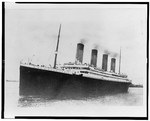In a time when technology was rapidly changing, shipping lines such as Cunard Line, White Star Line, Norddeutscer-Lloyd, and Hamburg-Amerika were competing to be the fastest and most elegant ships on the sea. From 1812 to 1912 the rate of sea travel nearly quadrupled- a trip across the north Atlantic that once took over a month to complete now took just one week. In the spirit of this competition, a plan was hatched- not to be the fastest, but to make the most luxurious ships in the world.
On a warm summer evening in 1907, managing director of White Star Line, Bruce Ismay, and senior partner and chairman of the shipyard Harland and Wolff, Lord Pirrie, conspired to build a ship bigger and better than its rival company, The Cunard Line. After the dinner, the two schemed to create three of the most luxurious ships ever to be created; the Olympic, Titanic, and Gigantic (later renamed Britannic) which would be ready 1911, 1912, and 1913 respectively.
Work began in December 1907 on the first of the three mammoth ships to be constructed, the Olympic. In order to accommodate the size of the Olympic and Titanic, the largest gantry ever constructed was built so that workers could access all parts of the ship. Construction on the Titanic began on March 31, 1909. At the peak of construction, Harland and Wolff shipyard employed approximately 14,000 men to build the enormous ships.
It took over one year to fully frame the Titanic. Large steel plates were then riveted to the frame. It took more than three million rivets to hold the steel in place. In October 1910, the shell plating on the Titanic was complete.
In the hull, the Titanic had 29 boilers, containing 159 furnaces, which powered two reciprocating engines. The reciprocating engines were the largest ever built at nearly forty feet tall and nine feet in diameter. The boilers were also massive; looming at two stories tall. In 1912, when the ship was completed, it was the largest man made object ever to be built.
The Titanic was claimed to be “virtually unsinkable” due to its watertight construction. It had 15 watertight bulkheads that divided the ship into 16 compartments. The thought was that if four smaller compartments flooded, the boat could still float. However, the bulkheads only reached about 10 feet above the waterline, allowing water to reach from one compartment to another, thus defeating the purpose of the bulkheads.
In May 1911, the Titanic was released from its dry dock and the interior work began. The grandeur and opulence had never been conceived and has not been duplicated since. Everything on board was either brand new or specifically made and designed for the ship and was designed to make the passengers comfortable throughout the voyage. Every cabin or suite had running water, a luxury few of the third-class passengers would have had at home. Perhaps the most iconic of the Titanic’s grandeur was the first class passenger’s grand staircase. The staircase was lit with natural light through the glass dome and illuminated at night with crystal lights.
As was custom for White Star Line, the Titanic was not christened with champagne or wine when it left its dry dock on May 31, 1911; however, a large crowd of nearly 100,000 watched the Titanic glide into the water. On board included J. Pierpoint Morgan, financier of the White Star Line; Lord Pirrie, chairman of Harland and Wolff; J. Bruce Ismay, chairman of the White Star Line; and Thomas Andrews, Harland and Wolff’s managing director who oversaw the building of the Titanic.
On April 2, 1912, the Titanic completed its sea trials and was deemed sea worthy. Eight short days later, the Titanic would set sail on its maiden and last voyage.

